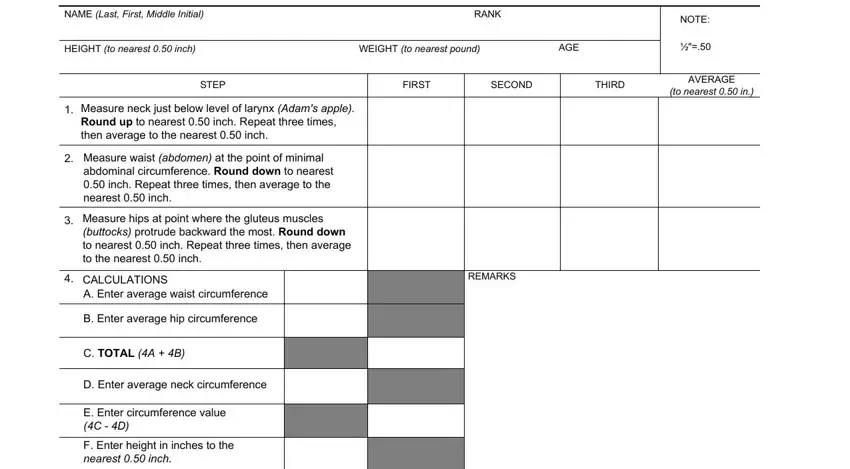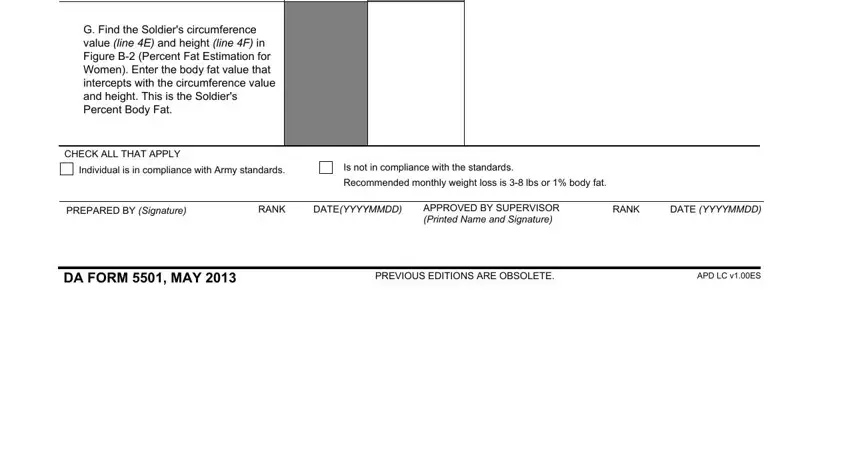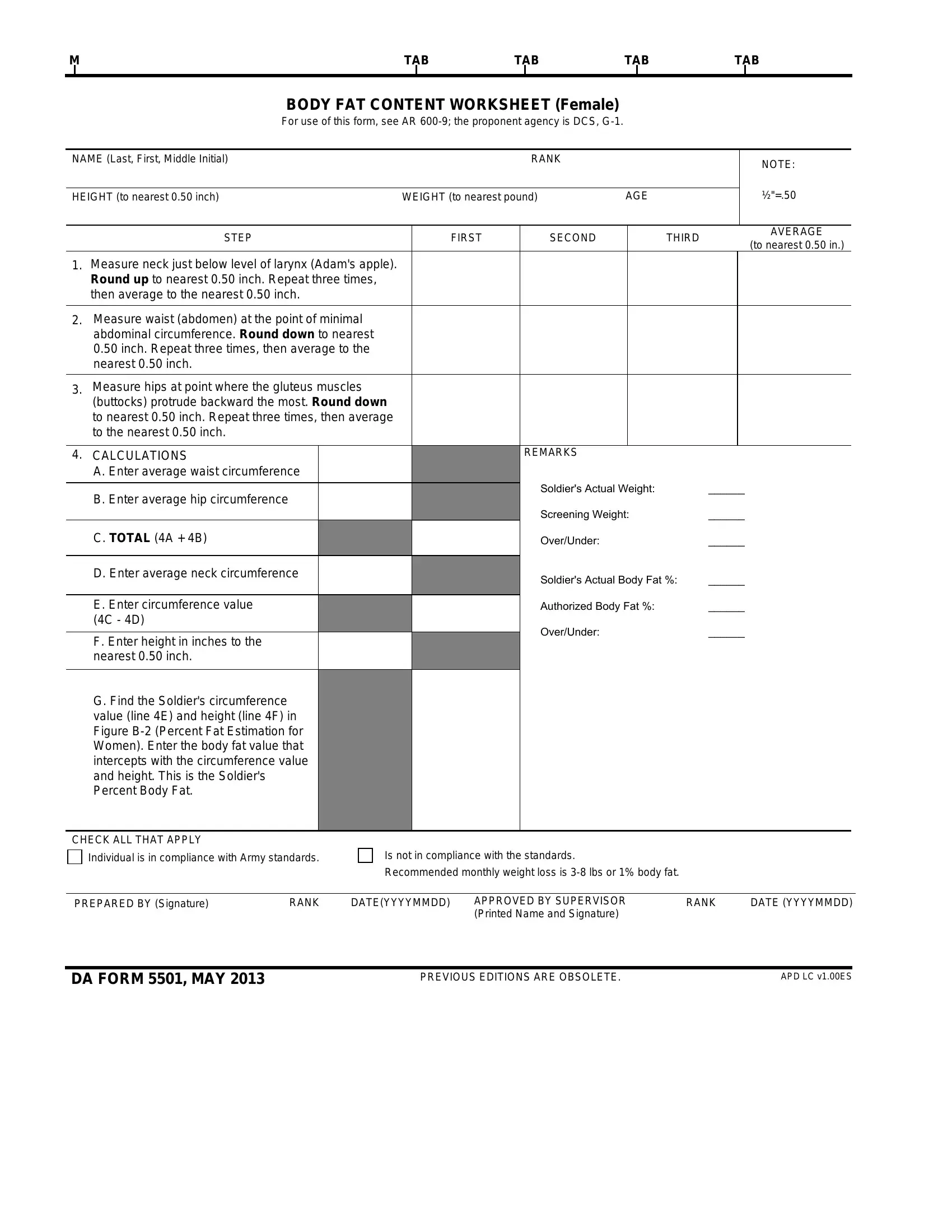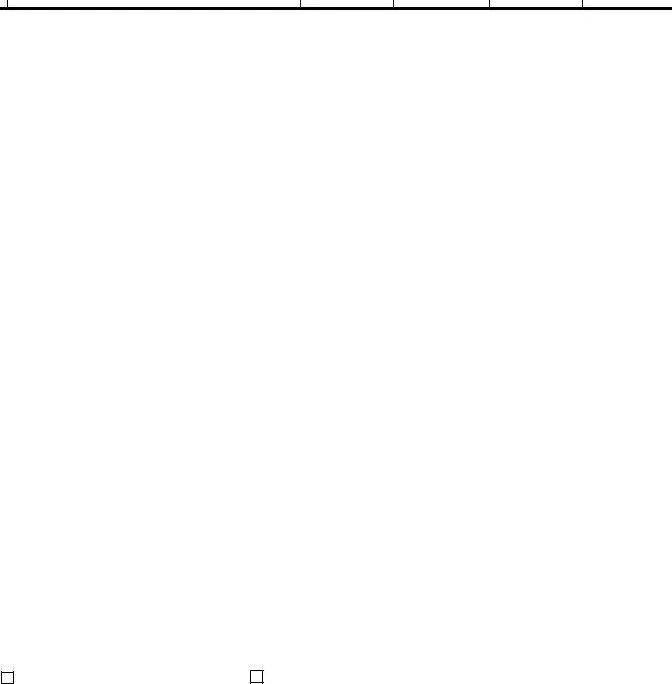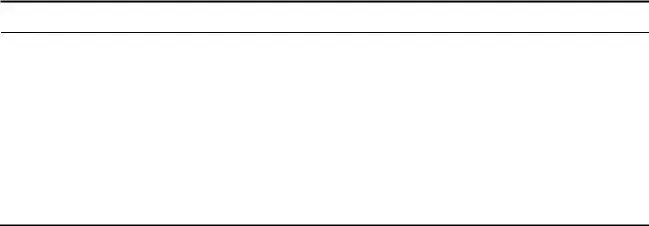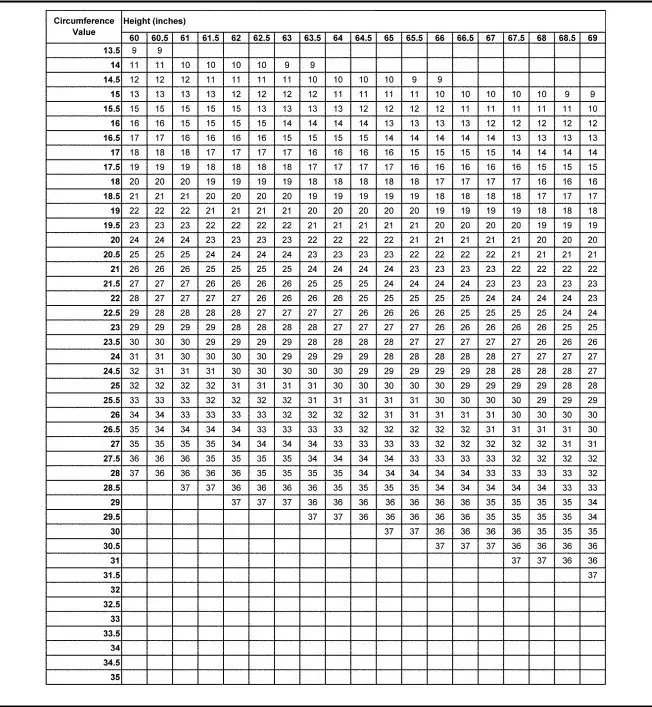MTABTABTABTAB
BODY FAT CONTENT WORKSHEET (Female)
For use of this form, see AR 600-9; the proponent agency is DCS, G-1.
NAME (Last, First, Middle Initial) |
|
|
|
|
|
|
RANK |
|
|
|
NOTE: |
|
|
|
|
|
|
|
|
|
|
|
|
|
|
|
|
|
|
|
|
|
|
½"=.50 |
|
HEIGHT (to nearest 0.50 inch) |
|
|
|
WEIGHT (to nearest pound) |
AGE |
|
|
|
|
|
|
|
|
|
|
|
|
|
|
|
STEP |
|
|
|
|
|
FIRST |
SECOND |
THIRD |
AVERAGE |
|
|
|
|
|
|
(to nearest 0.50 in.) |
|
|
|
|
|
|
|
|
|
|
|
1. Measure neck just below level of larynx (Adam's apple). |
|
|
|
|
|
|
|
|
Round up to nearest 0.50 inch. Repeat three times, |
|
|
|
|
|
|
|
|
|
then average to the nearest 0.50 inch. |
|
|
|
|
|
|
|
|
|
|
2. Measure waist (abdomen) at the point of minimal |
|
|
|
|
|
|
|
|
|
abdominal circumference. Round down to nearest |
|
|
|
|
|
|
|
|
|
0.50 inch. Repeat three times, then average to the |
|
|
|
|
|
|
|
|
|
nearest 0.50 inch. |
|
|
|
|
|
|
|
|
|
|
|
|
3. Measure hips at point where the gluteus muscles |
|
|
|
|
|
|
|
|
|
(buttocks) protrude backward the most. Round down |
|
|
|
|
|
|
|
|
to nearest 0.50 inch. Repeat three times, then average |
|
|
|
|
|
|
|
|
to the nearest 0.50 inch. |
|
|
|
|
|
|
|
|
|
|
|
|
|
|
|
|
|
|
|
|
|
|
|
|
|
4. CALCULATIONS |
|
|
|
|
|
|
REMARKS |
|
|
|
|
|
A. Enter average waist circumference |
|
|
|
|
|
|
|
|
|
|
|
B. Enter average hip circumference |
|
|
|
|
|
|
Soldier's Actual Weight: |
______ |
|
|
|
|
|
|
|
|
Screening Weight: |
______ |
|
|
|
|
|
|
|
|
|
|
|
C. TOTAL (4A + 4B) |
|
|
|
|
|
|
Over/Under: |
|
______ |
|
|
|
|
|
|
|
|
|
|
|
|
|
|
D. Enter average neck circumference |
|
|
|
|
|
Soldier's Actual Body Fat %: |
______ |
|
|
|
|
|
|
|
|
|
|
|
|
|
|
|
|
|
|
|
|
|
|
|
|
E. Enter circumference value |
|
|
|
|
|
|
Authorized Body Fat %: |
______ |
|
|
(4C - 4D) |
|
|
|
|
|
|
Over/Under: |
|
______ |
|
|
F. Enter height in inches to the |
|
|
|
|
|
|
|
|
|
|
|
|
|
|
|
|
|
|
|
|
|
nearest 0.50 inch. |
|
|
|
|
|
|
|
|
|
|
|
|
G. Find the Soldier's circumference |
|
|
|
|
|
|
|
|
|
|
|
|
value (line 4E) and height (line 4F) in |
|
|
|
|
|
|
|
|
|
|
|
Figure B-2 (Percent Fat Estimation for |
|
|
|
|
|
|
|
|
|
|
|
Women). Enter the body fat value that |
|
|
|
|
|
|
|
|
|
|
|
intercepts with the circumference value |
|
|
|
|
|
|
|
|
|
|
|
and height. This is the Soldier's |
|
|
|
|
|
|
|
|
|
|
|
|
Percent Body Fat. |
|
|
|
|
|
|
|
|
|
|
|
|
|
|
|
|
|
|
|
|
|
|
|
|
|
CHECK ALL THAT APPLY |
|
|
|
|
|
|
|
|
|
|
|
|
□ Individual is in compliance with Army standards. |
□ |
Is not in compliance with the standards. |
|
|
|
|
|
|
|
|
|
Recommended monthly weight loss is 3-8 lbs or 1% body fat. |
|
|
|
|
|
|
|
|
|
|
|
|
|
|
|
|
PREPARED BY (Signature) |
RANK |
DATE(YYYYMMDD) |
APPROVED BY SUPERVISOR |
RANK |
DATE (YYYYMMDD) |
|
|
|
|
|
|
(Printed Name and Signature) |
|
|
|
|
|
|
|
|
|
|
|
|
|
|
|
|
|
DA FORM 5501, MAY 2013 |
|
|
|
|
PREVIOUS EDITIONS ARE OBSOLETE. |
|
|
|
APD LC v1.00ES |
|
|
|
|
|
|
|
|
|
|
|
Appendix B
Standard Methods for Determining Body Fat Using Body Circumferences, Height, and Weight
B–1. Height and weight measurements
The procedures for the measurements of height, weight, and specific body circumferences for the estimation of body fat are described in this appendix. The weight for height table is listed in table B–1 followed by the body fat standards in table B–2.
a.Soldier’s height: The height will be measured with the Soldier in stocking feet (without running shoes) and wearing the authorized physical fitness uniform (trunks and T-shirt). The Soldier will stand on a flat surface with the head held horizontal, looking directly forward with the line of vision horizontal and the chin parallel to the floor. The body will be straight but not rigid, similar to the position of attention. When measuring height to determine body fat percentage (see fig B–1 or fig B–2), the Soldier’s height is measured to the nearest half inch. When measuring height to use the weight for height screening table (see table B–1) the Soldier’s height is measured and then rounded to the nearest inch with the following guidelines:
(1)If the height fraction is less than half an inch, round down to the nearest whole number in inches.
(2)If the height fraction is half an inch or greater, round up to the next highest whole number in inches.
b.Soldier’s weight: The weight will be measured with the Soldier in stocking feet and wearing the authorized physical fitness uniform (trunks and T-shirt); running shoes and jacket will not be worn. Scales used for weight measurement will be calibrated annually for accuracy. The measurement will be made on scales available in units and recorded to the nearest pound with the following guidelines:
(1)If the weight fraction of the Soldier is less than one-half pound, round down to the nearest pound.
(2)If the weight fraction of the Soldier is one half-pound or greater, round up to the next whole pound.
(3)No weight will be deducted to account for clothing.
c.Scales used for weight measurement will be calibrated annually. The word "calibrated", is intended to ensure the personnel weight scales used at the unit level for height and weight measurements have been verified for accuracy. It is not intended to require that unit scales be calibrated by test, measurement, and diagnostic equipment personnel or biomed- ical technicians. Accuracy of scales will be verified by unit personnel that will be performing the height/weight screening. This may be verified by using the tare (zero) function (if available), by following the scale manufacturer's instructions for ensuring accuracy, or by using an object of fixed known weight. Following is an example of using an object of fixed weight (for example, weight labeled 5 pounds) as means to verify accuracy:
(1)Place an object of known, fixed weight on the scale.
(2)Compare the reading on the scale to the known weight of the object.
(3)If the scale reading differs from the known weight of the object being weighted the scale has a calibration feature, adjust the scale until the reading matches the known weight of the object being weighed. Once the reading matches the known weight, the scale is considered to be accurate for the purpose of this regulation.
(4)If the reading differs from the known weight of the object being weighed and the scale does not have a calibration feature the scale should not be used to determine Soldier compliance with this regulation.
(5)Once accuracy of scale has been verified, affix a label to the scale with name, date, and signature of the individual verifying the accuracy of the scale. The unit commander will also sign as a witness.
Table B–1
Weight for height table (screening table weight)—Continued
|
|
Male weight in pounds, by age |
|
Female weight in pounds, by age |
|
|
|
|
|
|
|
|
|
|
|
|
Minimum |
|
|
|
|
|
|
|
|
|
|
|
|
|
|
|
|
|
Height |
weight1 |
|
|
|
|
|
|
|
|
(inches) |
(pounds) |
17–20 |
21–27 |
28–39 |
40+ |
17–20 |
21–27 |
28–39 |
40+ |
|
|
|
|
|
|
|
|
|
|
58 |
91 |
- |
- |
- |
- |
119 |
121 |
122 |
124 |
|
|
|
|
|
|
|
|
|
|
59 |
94 |
- |
- |
- |
- |
124 |
125 |
126 |
128 |
|
|
|
|
|
|
|
|
|
|
60 |
97 |
132 |
136 |
139 |
141 |
128 |
129 |
131 |
133 |
|
|
|
|
|
|
|
|
|
|
61 |
100 |
136 |
140 |
144 |
146 |
132 |
134 |
135 |
137 |
|
|
|
|
|
|
|
|
|
|
62 |
104 |
141 |
144 |
148 |
150 |
136 |
138 |
140 |
142 |
|
|
|
|
|
|
|
|
|
|
AR 600–9 • 16 July 2019 |
23 |
Table B–1
Weight for height table (screening table weight)—Continued
|
|
Male weight in pounds, by age |
|
Female weight in pounds, by age |
|
|
|
|
|
|
|
|
|
|
|
63 |
107 |
145 |
149 |
153 |
155 |
141 |
143 |
144 |
146 |
|
|
|
|
|
|
|
|
|
|
64 |
110 |
150 |
154 |
158 |
160 |
145 |
147 |
149 |
151 |
|
|
|
|
|
|
|
|
|
|
65 |
114 |
155 |
159 |
163 |
165 |
150 |
152 |
154 |
156 |
|
|
|
|
|
|
|
|
|
|
66 |
117 |
160 |
163 |
168 |
170 |
155 |
156 |
158 |
161 |
|
|
|
|
|
|
|
|
|
|
67 |
121 |
165 |
169 |
174 |
176 |
159 |
161 |
163 |
166 |
|
|
|
|
|
|
|
|
|
|
68 |
125 |
170 |
174 |
179 |
181 |
164 |
166 |
168 |
171 |
|
|
|
|
|
|
|
|
|
|
69 |
128 |
175 |
179 |
184 |
186 |
169 |
171 |
173 |
176 |
|
|
|
|
|
|
|
|
|
|
70 |
132 |
180 |
185 |
189 |
192 |
174 |
176 |
178 |
181 |
|
|
|
|
|
|
|
|
|
|
71 |
136 |
185 |
189 |
194 |
197 |
179 |
181 |
183 |
186 |
|
|
|
|
|
|
|
|
|
|
72 |
140 |
190 |
195 |
200 |
203 |
184 |
186 |
188 |
191 |
|
|
|
|
|
|
|
|
|
|
73 |
144 |
195 |
200 |
205 |
208 |
189 |
191 |
194 |
197 |
|
|
|
|
|
|
|
|
|
|
74 |
148 |
201 |
206 |
211 |
214 |
194 |
197 |
199 |
202 |
|
|
|
|
|
|
|
|
|
|
75 |
152 |
206 |
212 |
217 |
220 |
200 |
202 |
204 |
208 |
|
|
|
|
|
|
|
|
|
|
76 |
156 |
212 |
217 |
223 |
226 |
205 |
207 |
210 |
213 |
|
|
|
|
|
|
|
|
|
|
77 |
160 |
218 |
223 |
229 |
232 |
210 |
213 |
215 |
219 |
|
|
|
|
|
|
|
|
|
|
78 |
164 |
223 |
229 |
235 |
238 |
216 |
218 |
221 |
225 |
|
|
|
|
|
|
|
|
|
|
79 |
168 |
229 |
235 |
241 |
244 |
221 |
224 |
227 |
230 |
|
|
|
|
|
|
|
|
|
|
802 |
173 |
234 |
240 |
247 |
250 |
227 |
230 |
233 |
236 |
Note:
1Male and female Soldiers who fall below the minimum weights shown in table B–1 will be referred by the commander for immediate medical evaluation.
2Add 6 pounds per inch for males over 80 inches and 5 pounds per inch for females over 80 inches.
B–2. Determining body fat using body circumference process
a.Although circumferences may be looked upon by untrained personnel as easy measures, they can give erroneous results if proper technique is not followed. The individual taking the measurements must have a thorough understanding of the appropriate body landmarks and measurement techniques. Unit commanders will require that designated personnel have read the instructions regarding technique and location and obtained adequate practice before official body fat deter- minations are made. Individuals taking the measurements will be designated unit fitness trainers, certified in body circum- ference methodology, a certified master fitness trainer, and/or a NCO trained in body circumference methodology, as specified in paragraph 2–16b(1) and/or 2–17a(1). Two members of the unit will be utilized in the taking of measurements; one to place the tape measure and determine measurements and the other to assure proper placement and tension of the tape, as well as to record the measurement on the DA Form 5500 and DA Form 5501. The unit member recording the measurements is responsible for signing the DA Form 5500 and DA Form 5501 in the “prepared by” block. Soldiers should be measured by trained individuals of the same gender. If a trained individual of the same gender is not available to conduct the measurements, a female Soldier will be present when a male measures a female, and a male Soldier will be present when a female measures a male. The two will work with the Soldier between them so the tape is clearly visible from all sides. Take all circumference measurements sequentially three times and record them to the nearest half inch. If any one of the three closest measurements differs by more than 1 inch from the other two, take an additional measurement and compute a mathematical average of the three measurements with the least difference to the nearest half inch and record this value.
b.Soldiers will be measured for body fat in stocking feet and standard Army physical fitness uniform trunks and T- shirt. Undergarments that may serve to bind the abdomen, hip, or thigh areas are not authorized for wear when a Soldier is being measured for body fat composition. This includes, but is not limited to spandex shorts or girdle-like undergarments.
c.When measuring circumferences, compression of the soft tissue requires constant attention. The tape will be applied so it makes contact with the skin and conforms to the body surface being measured. It will not compress the underlying
24 |
AR 600–9 • 16 July 2019 |
soft tissues. However, the hip circumference measurement requires more firm pressure to compress the authorized physical fitness uniform trunks. All measurements are made in the horizontal plane (parallel to the floor), unless indicated otherwise.
d.The tape measure will be made of a non-stretchable material, preferably fiberglass; cloth or steel tapes are unaccepta- ble. Cloth measuring tapes will stretch with usage and most steel tapes do not conform to body surfaces. The tape measure will be calibrated, that is, compared with a yardstick or a metal ruler to ensure validity. This is done by aligning the fiberglass tape measure with the quarter-inch markings on the ruler. The markings will match those on the ruler; if not, do not use that tape measure. The tape will be one-quarter to one-half inch wide (not exceeding one-half inch) and a minimum of 5 feet in length. A retractable fiberglass tape is the best type for measuring all areas.
Note. Tapes are currently available through the Army Supply System (Federal stock number 5210–01–238–8103 or na- tional stock number 8315–01–238–8103). The current Army supply system or any other fiberglass tape (not to exceed one-half inch) may be used if retractable tapes cannot be purchased by unit budget funds available and if approved by installation commanders.
e.If using the circumference methodology outlined in this policy and it is determined that the Soldier’s body circum- ference does not meet the ABCP standards, a confirmation will be completed. The above process will be completed by a different team than the completed initial set of measurement. This must occur before any actions are taken by the com- mander.
Table B–2
Maximum allowable percent body fat standards—Continued
Age group: 17–20
Male (% body fat): 20%
Female (% body fat): 30%
Age group: 21–27
Male (% body fat): 22%
Female (% body fat): 32%
Age group: 28–39
Male (% body fat): 24%
Female (% body fat): 34%
Age group: 40 and older
Male (% body fat): 26%
Female (% body fat): 36%
AR 600–9 • 16 July 2019 |
25 |
Figure B–1. Percent fat estimates for males
26 |
AR 600–9 • 16 July 2019 |
